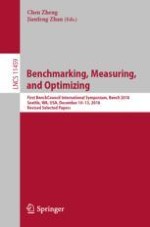2019 | Book
Benchmarking, Measuring, and Optimizing
First BenchCouncil International Symposium, Bench 2018, Seattle, WA, USA, December 10-13, 2018, Revised Selected Papers
Editors: Chen Zheng, Jianfeng Zhan
Publisher: Springer International Publishing
Book Series : Lecture Notes in Computer Science
